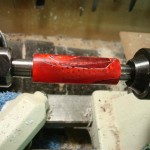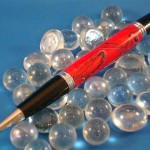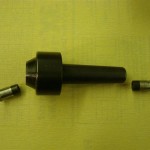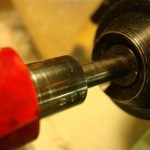A finely crafted pen needs to have a perfect interface between the blank and the pens gripping parts. This is especially true in areas where the writers fingers can feel the interface between the blank and metal parts of the pen.
One of the biggest annoyances when turning pens is getting the bushing-mandrel to run true.
I have experimented with different style mandrels and various types of head and tail stock interfaces.
I found this setup to work the best:
- The mandrels that are of the collet type and can accommodate a draw-bar provide the best headstock interface. These type of mandrel allows the mandrel shaft to be shortened to the length of the pen blank, reducing the mandrels overall length and therefore the amount of runout.
- The tail-stock end of many mandrel shafts are flat or have a cone interface. The shape of live center that you use makes a big difference. If the point in the live center is not the same angle and depth as the dimple in the end of the mandrel, the mandrel will not run perfectly true. I improved on this setup by flattening the point on the live center so that there was more connecting area at the shaft interface rather than contacting on a small point.
In the setup described above the force exerted by the shaft nut and the force applied with the tail stock still needs to be properly controlled to minimize run out. I found this method still lacking in predictability.
While thumbing through my new Penstate Industries catalog a new gadget “Pen Mandrel Saver” caught my eye and i decided to try it out.
I thought this was a good idea but wanted to make sure it worked.
I searched my bushing collection and found a set of bushings that when turned to fit the opening in my standard live center it could simulate the same function. I used a set of pen bushings because they already have a precision 7mm hole. You need to use a live center that is hollow so the 7mm shaft can extend into it. This is the one I used after knocking out the point. Woodcraft live center.
I turned bushings on my Taig mini lathe for both the front and the back of the live center figuring that if the shaft extended into center, the bitter end should have a bearing surface as well.
As seen below I inserted the bushings into both ends of the live center mounted up the pen blank and tried it out. The pen “turnedout right” 🙂
This method is much more stable and is also easier to setup. Perhaps PenState finally has solved an age old mandrel problem!
To scroll through the pictures click on the first one and use the NEXT -PREVIOUS buttons on the left and right of the picture!
Blank between center Finished test pen Mandrel with both bushings Bushing in live center



